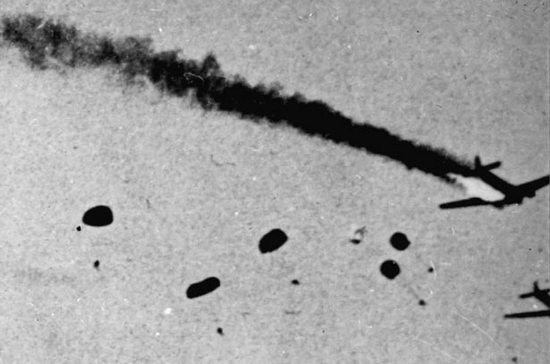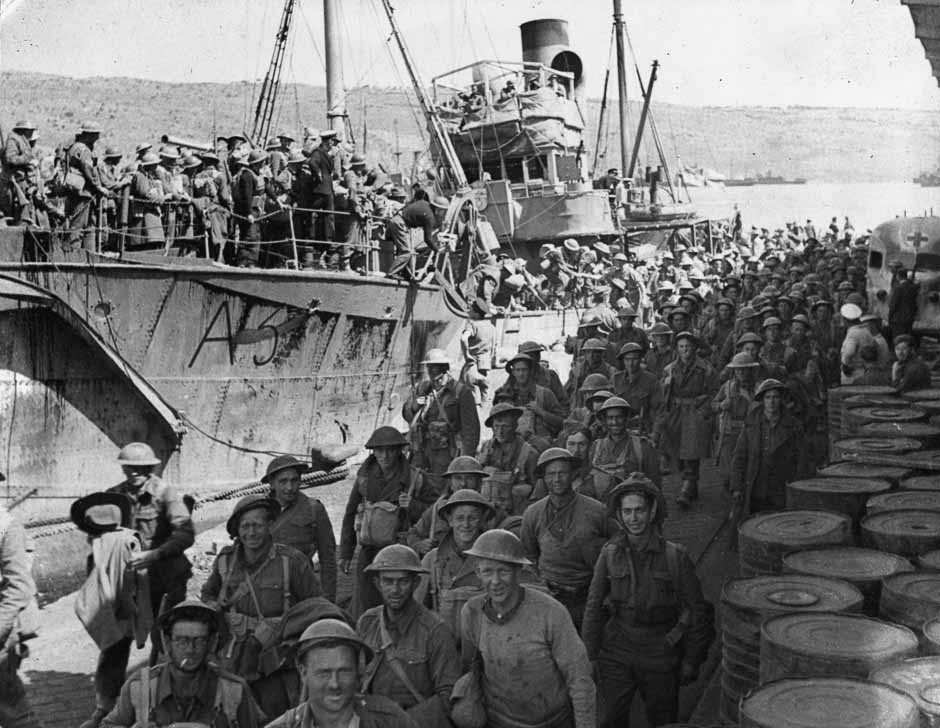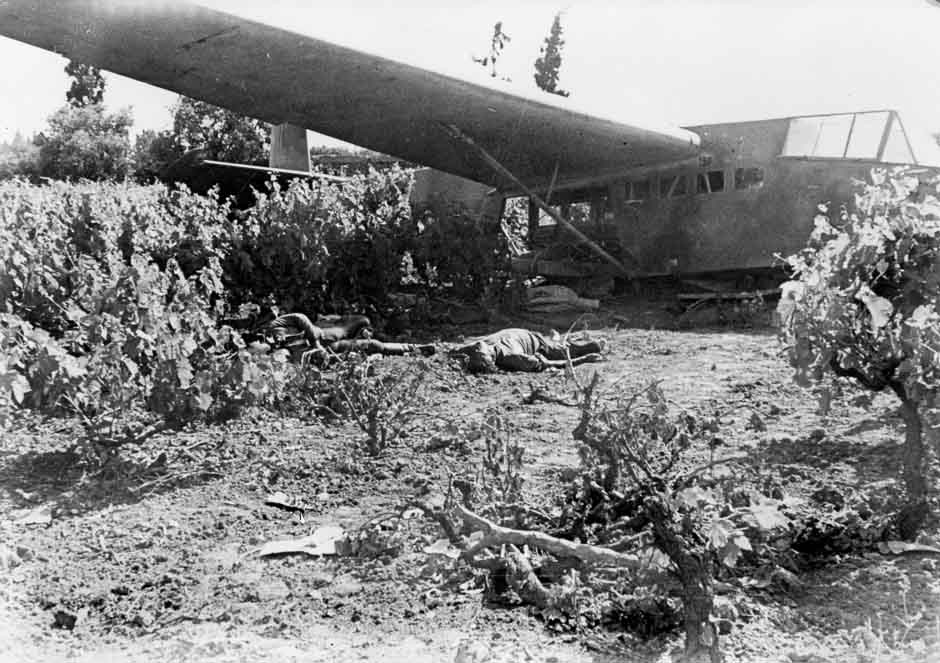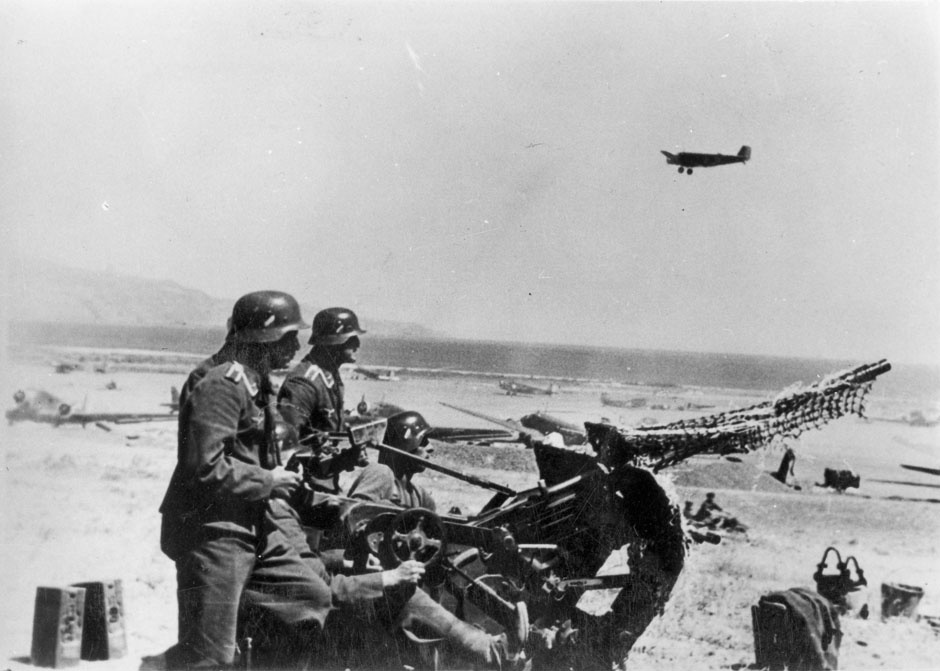The invasion of Crete – Operation Merkur
Introduction
It began just after dawn on 20 May 1941. Many of the 7700 New Zealand soldiers stationed on Crete were finishing breakfast when hundreds of German transport aircraft – some towing gliders – rumbled in over the Mediterranean island. The air above was suddenly filled with parachutes as thousands of elite German paratroops began to descend from the sky.
This was the start of what is known as the Battle for Crete. For 12 dramatic days New Zealanders, British, Australian and Greek troops, assisted by Cretan civilians, tried to repel a huge airborne assault by the Germans. They almost succeeded.
Many New Zealanders made it off Crete, but thousands were left behind: more than 2000 were taken prisoner; 671 died. Among those evacuated were Charles Upham and Alfred Hulme, both of whom won the Victoria Cross (VC) for their actions on Crete. A few New Zealanders took to the hills, sheltered by the Cretans who, to this day, remember New Zealand’s role in the battle.
Overview
The Battle for Crete was one of the most dramatic battles of the Second World War. Over 12 days in May 1941 a mixed force of New Zealanders, British, Australian and Greek troops desperately tried to fight off a huge German airborne assault. Despite suffering appalling casualties, the parachutists and glider-borne troops who led the invasion managed to secure a foothold on the island and eventually gained the upper hand. The battle ended with the evacuation to Egypt of the bulk of the Allied force.
Greek campaign
Crete became a German target following their rapid occupation of the Greek mainland in April 1941. German forces had surged into the Balkans, quickly defeating Yugoslavia and outflanking Greek border defences. The 2nd New Zealand Division – part of a Commonwealth force hastily deployed to help the Greeks – was soon in the thick of the action. Outgunned and outnumbered, it was forced to conduct a fighting withdrawal south through Greece. During the last week of April more than 50,000 Allied troops were evacuated from the mainland, including most of the 2nd New Zealand Division. In this brief campaign nearly 300 New Zealanders were killed and 1800 captured.
Attention now turned to Crete. The German High Command debated whether to seize the island or focus efforts on the planned invasion of the Soviet Union. Capturing Crete would have its advantages. It would both give the Germans a good base in the eastern Mediterranean and prevent the British using it to mount operations in the Balkans. A seaborne invasion ran the risk of disruption by British naval forces, but the Germans could also call on highly trained airborne forces. After being assured that it would not seriously disrupt his plans in Eastern Europe, Adolf Hitler reluctantly agreed to the invasion of Crete – Operation Merkur (Mercury).
To Crete
Most of the Allied troops evacuated from Greece were sent to Crete. By the end of April there were more than 42,000 British, Commonwealth and Greek soldiers on the island. This force included the bulk of the New Zealand Division (7700 men). One brigade had gone directly to Egypt and it was expected that those on Crete would quickly follow. But faced with shipping shortages and the threat of German attack, the British decided to use the men already on the island for its defence.
On 30 April command of ‘Creforce’ – the designation for the Allied troops on the island – was entrusted to Major-General Bernard Freyberg, who led the 2nd New Zealand Expeditionary Force (2NZEF). He faced a daunting task. During the withdrawal from Greece the British had been forced to abandon their heavy equipment and transport. Most soldiers arrived on Crete with little more than their personal weapons. Ammunition and stores were in short supply, and a lack of tools saw troops digging defensive positions with steel helmets. Heavy weapons – tanks and artillery – were few and far between. Air support was also scarce as the Royal Air Force (RAF) was preoccupied elsewhere in the Mediterranean.
Geography also made the job of defending Crete tough. The key points on the island were the airfields at Maleme, Retimo and Heraklion, and the port at Suda Bay. All were located on the northern coast and faced German-occupied Greece – at its nearest point little more than 100 km away. The loss of any of these positions would make the defence of the island virtually impossible, given the Germans’ ability to quickly deliver men and supplies from bases on the mainland. Yet the British were unwilling to destroy them – the port at Suda Bay was essential to the supply of Creforce, and it was still hoped that the RAF could operate from the island in the future.
Despite these problems, the British had one major advantage – they were fully aware of German plans for an invasion of Crete. This information was derived from deciphered German codes, dubbed ULTRA intelligence by the Allies. The only details that the British were not aware of were the invasion date and the comparative strengths of German sea and airborne forces. Armed with this knowledge, British Prime Minister Winston Churchill was convinced that the defenders of Crete stood a good chance of repelling the invasion and achieving a morale-boosting victory over the Germans.
Air attack
The British expected the Germans to launch their attack on the island in mid-May 1941. The Germans planned to begin the invasion on the 15th, but supply problems in Greece delayed the assault by a week. Informed by ULTRA sources of these changes, Freyberg was confident that he had done all that was possible to meet it with the limited resources and time available.
The invasion began on the morning of 20 May. Shortly after 8 a.m., the men of Creforce saw gliders in the sky overhead, quickly followed by the rumbling of an approaching air armada. Hundreds of planes lumbered through the sky, dropping German paratroops into the area around Maleme and the township of Canea. Later in the day, paratroops dropped into the area around the airfields at Retimo and Heraklion.
German casualties mounted quickly. Many paratroops died before they could reach the ground; others were mown down after landing as they struggled to release themselves from their parachutes. Despite heavy losses, enough troops landed safely to secure tenuous footholds west of Maleme (an area mistakenly left unguarded by Freyberg) and in the Prison Valley, south-west of Canea.
By the end of the day German forces around Maleme, Retimo and Heraklion had failed to secure any of their objectives. Their commanders in Athens feared the operation was a failure and the prospect of a humiliating defeat loomed. It was decided to throw all available resources into an attack on Maleme the next day. Securing the airfield was the key to the success of the invasion; without it, reinforcements could not be sent in.
German victory
The decision to concentrate on Maleme paid off for the Germans. On the morning of 21 May it became clear that the New Zealand infantry battalions defending the airfield and the key high ground overlooking it had withdrawn. This crucial mistake effectively sealed the fate of Creforce. Although the airfield was still under artillery fire, the Germans wasted no time flying in reinforcements which tipped the balance of the battle in their favour.
The cost of battle
More than 1700 British, Commonwealth and Greek soldiers were killed and 15,000 captured during the Battle for Crete. There were 671 New Zealanders among the dead, and 2180 Kiwi prisoners of war. More than 6000 Germans were killed or wounded. The Luftwaffe lost more than 350 aircraft.
Fresh troop reinforcements and the dominance of the Luftwaffe (German air force) above Crete left the defenders facing impossible odds. After six days of hard fighting Freyberg received the order to evacuate his weary forces. Parts of Creforce pulled back to Sfakia on the south coast, and from here about 10,500 troops left the island over four nights. A separate evacuation at Heraklion rescued a further 6000 soldiers, although a number of these men were killed by air attacks on their ships during the return journey to Egypt.
The soldiers left behind – around 6500 – formally surrendered to the Germans on 1 June. The majority would spend the rest of the war in prisoner of war camps – initiallly in Italy and later in Germany and Poland. Others took to the hills, some later escaping to Egypt by submarine or fishing boat. With the help of Cretan civilians, a handful of men eluded capture on the island for years and took part in resistance fighting.
Day one – 20 May 1941: the invasion begins
On 20 May 1941 the Germans launched their invasion of Crete. Landing among or near concealed defensive positions, the glider-borne troops and paratroops suffered heavy casualties. Pockets of survivors managed to establish a foothold on the island, but at the end of the first day the German position was still extremely tenuous.
Maleme airfield
The invasion began after dawn on 20 May 1941 with a heavy bombardment by the Luftwaffe (German air force). For the New Zealanders on Crete – who had endured daily air attacks for over a week – the arrival of German aircraft promised just another day of bombing and strafing. Around 7.30 a.m. there was a lull in the attack, during which many of the men prepared to have breakfast. Before they had a chance to eat, a more intense air bombardment began. Shortly after 8 a.m. gliders began to appear in the sky – the first sign that something significant was happening. As the gliders passed overhead German transport planes lumbered into view and began emptying masses of paratroops and supply canisters. The sky above the New Zealanders was soon filled with a multitude of coloured parachutes.
Reactions to the invasion
I was scared stiff.
Spr John Haines, 7th Field Coy
Here the bastards come! My reaction was one of excitement.
Pte Ivan Divehall, 19th Bn
So this is it. Our OC simply said, ‘This is for real boys, put your bayonets on, it’s either you or them.’
Pte Walter Gibbons, 23rd Bn
I cried like a child, really frightened, then got stuck into the enemy.
Pte Howard Thomas, Div HQ
I was astonished. Some of our late arrivals from Greece told us of the parachutists at Corinth. ‘Bullshit’, we said – all the more realistic when the Deutsch did arrive. Tpr Bill Boyce, 4th Field Ambulance
Those on the ground were stunned by the spectacle above them. After a brief moment of hesitation the defenders grabbed their weapons and began firing on the figures floating down towards them. Rifles and machine guns took a terrible toll. Many paratroops died before they reached the ground while others were hit as they struggled to remove their cumbersome parachute harnesses. Cretans too became involved in the battle. Local villagers, armed with shotguns, axes and spades, attacked paratroops who landed near their homes. The Cretan population would later suffer terrible reprisals from the German occupation force for these actions.
Initial fighting was confined to the areas around Maleme and Canea–Galatas. About 50 gliders came down around Maleme – mainly along the dry Tavronitis riverbed. Paratroops were also dropped to the west, south and east of the Maleme airfield, with orders to seize control of the airfield and high ground overlooking it. Those who landed to the south and east came down amongst New Zealand units and were cut to pieces. In one parachute battalion, two-thirds of the men were killed. It was a different story west of the airfield. Most of the gliders had managed to land safely in an area that could not be observed by defenders on the higher ground. A substantial number of paratroops had also dropped in and around the Tavronitis riverbed – an area Freyberg had left undefended. These troops wasted little time in reorganising themselves and were soon threatening the airfield.
Defending the key positions at Maleme was 22nd Battalion. Under the command of First World War Victoria Cross (VC) winner Lieutenant-Colonel Leslie Andrew, the battalion occupied positions along the western edges of the airfield as well the substantial hill – known as Point 107 – overlooking it. By the afternoon the situation was serious enough for Andrew to seek additional support from 23rd Battalion, located to his east. This request was turned down by Brigadier James Hargest, commander of 5th (NZ) Brigade, who mistakenly believed 23rd Battalion was tied up dealing with enemy paratroops in its area.
In desperation Andrew decided to use his meagre reserve – two tanks and an infantry platoon – to drive the Germans back from the edge of the airfield. But the counter-attack petered out when the tanks broke down. Unable to contact his forward companies and fearing that the rest of the battalion would be cut off, Andrew decided to pull back from Point 107 to a nearby ridge. Hargest agreed to the withdrawal – famously replying, ‘if you must, you must’ – before ordering two companies forward to reinforce 22nd Battalion. One of these companies briefly reoccupied Point 107 before falling back, while the other failed to make contact in the dark and also withdrew. Andrew pulled his battalion back to link up with 21st Battalion in the east, leaving behind two forward companies fighting on the western edge of the airfield. Both companies managed to extricate themselves when they found that the rest of the battalion had withdrawn.
Galatas–Canea area
In the Galatas–Canea area, the German attack began with a glider assault. Glider-borne troops landed near Canea but were unable to achieve their main objectives – the capture of Canea and Suda – and were forced to surrender a few days later. German casualties during this operation were appalling as many of the gliders were shot down or wrecked on landing. Among those killed was General Wilhelm Sussmann, commander of the 7th Air Division.
The moment we left the planes we were met with extremely heavy small arms fire. From my aircraft we suffered particularly heavy casualties and only three men reached the ground unhurt… . The survivors rallied to a position near the prison where we became organised, collected equipment, and formed up for an attack up the hill to the north towards Galatas.
Karl Nuehoff, II Battalion, 3rd Parachute Regiment, in D.M. Davin, Crete, 1953, p. 142
The main concentration of German landings in this sector occurred in an area known as Prison Valley, south of Galatas. Two battalions of paratroops dropped astride the Canea–Alikianou road managed to establish a foothold around the Aghya Prison complex. Their presence threatened communications with 5th Brigade in the east and it became obvious that a strong counter-attack was needed.
Defending this area was Colonel Howard Kippenberger’s 10th (NZ) Brigade. He quickly realised that his exhausted composite brigade was in no shape to mount such an operation. At 4th (NZ) Brigade HQ, Brigadier Lindsay Inglis came to the same conclusion – he believed an attack by his brigade would clear the Germans from the Prison Valley and place it in a position to assist at Maleme. Freyberg rejected the idea and Inglis was ordered instead to mount a single-battalion attack. Two companies of 19th Battalion and three British light tanks set off, but made no significant progress and eventually withdrew.
At the end of the day the Germans’ foothold on the island was tenuous. Two waves of airborne troops had failed to secure the airfields or the port facility at Suda Bay. Though there had been small gains at Maleme, the second wave of German paratroops dropped near Retimo and Heraklion had met strong resistance and made no progress. German commanders in Athens feared the worst – that they had severely underestimated the number of defenders on Crete and were about to suffer a humiliating defeat.
Continue reading.
Source: http://www.nzhistory.net.nz/war/the-battle-for-crete












